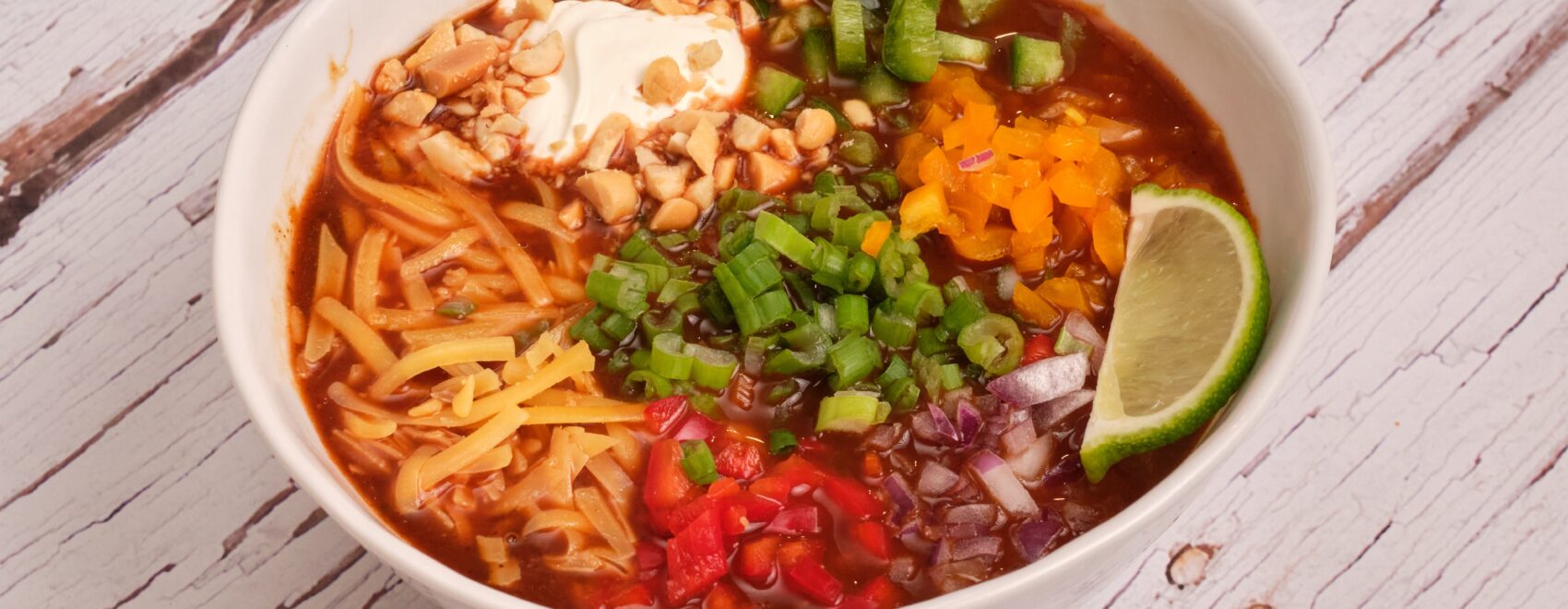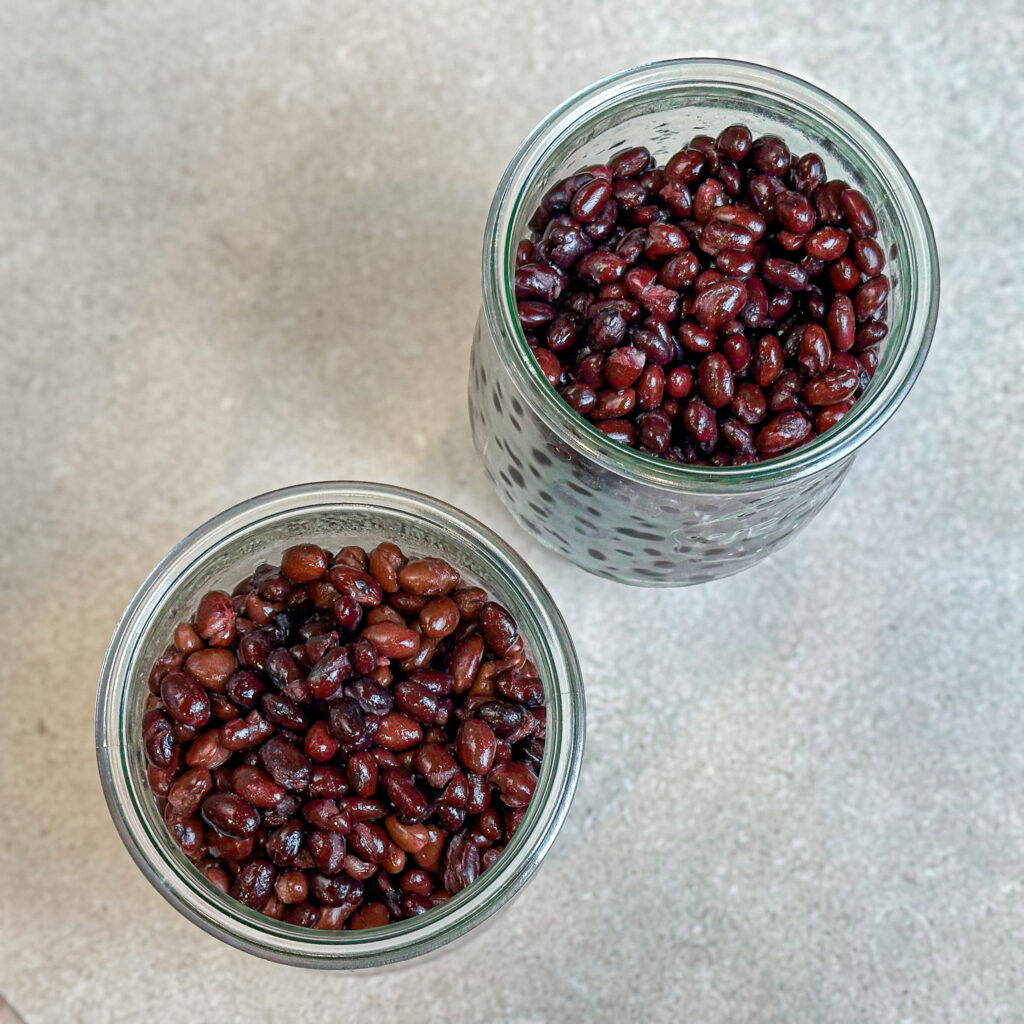
I tasted my first Black Bean Chili at the venerable Green’s vegetarian restaurant in San Francisco many moons ago. It was singularly delicious—an intriguing amalgam of deep, yet clean flavors. The Standard Bearer of Black Bean Chile.
Inspired, I proceeded over the years to create numerous variations on the Black Bean Chili and Chili Soup themes. This is the latest and quite possibly the best so far.

But titling this dish can be tricky due to the spelling. Is it chili or chile? It always surprises me when some folks lose their cool about something as harmless as a misspelling. No way to begin a beautiful, promising new year.
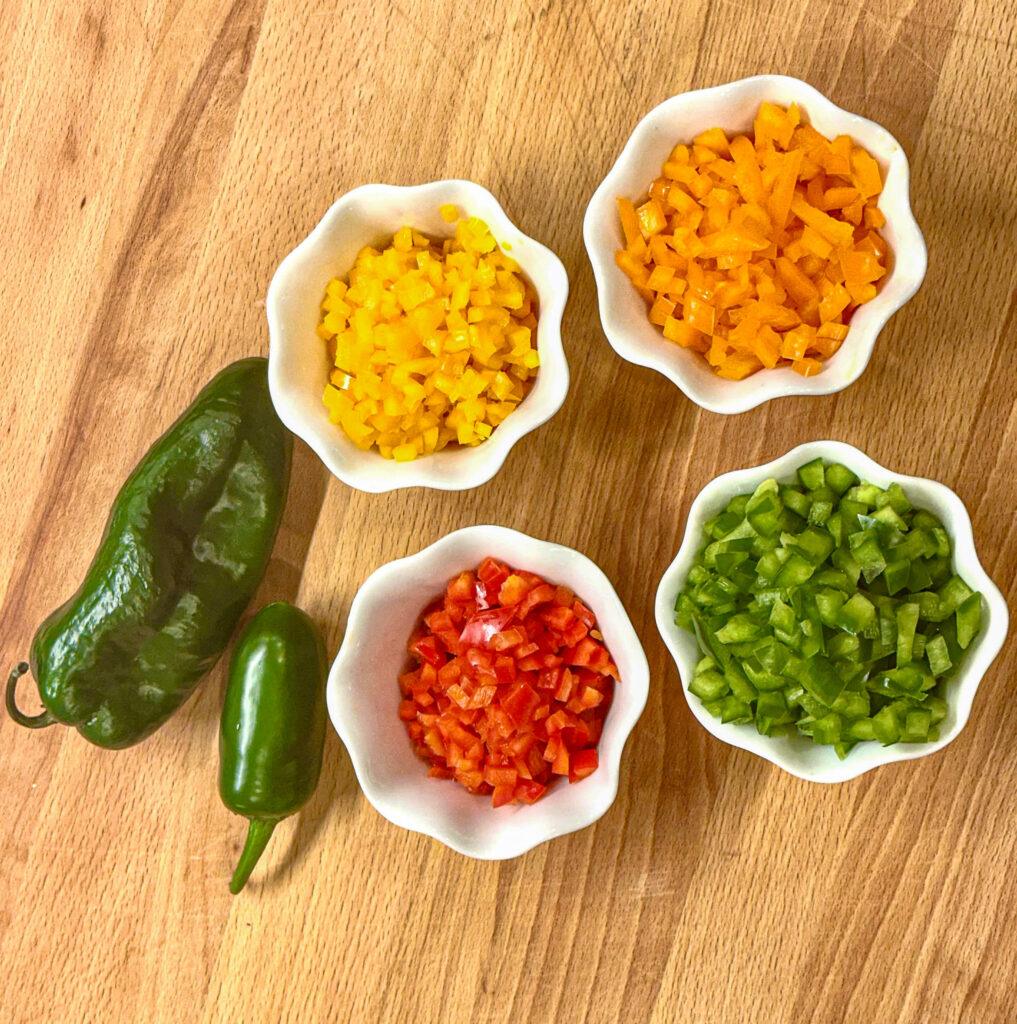
This said, I have been rebuked more than once on my spelling of the word, chile. To set the record straight (hopefully), chile with an “e” at the end is the Spanish spelling, and thus the more authentic spelling. Chili with an “i” at the end is the Americanized spelling, and whether we like it or not, that’s how language evolves over time.
However, to set the record straight, according to about.com, the “i” version began with the name for the American Southwest dish, Chili Con Carne, which was later shortened to chili. Today, blended chili powders typically feature the “i” spelling (such as Gebhardt chili powder), while single variety chile powders (ancho, chipotle, New Mexico, and so on) almost always feature the “e” spelling.
Of course, all chiles are members of the capsicum pepper family, so chile pepper is correct as well. I’ve also seen it spelled chilipepper. Are you laughing yet?
This said, when I refer to an American Southwest dish of chopped meat and/or beans simmered in a sauce containing dried or fresh chiles, I use the spelling “chili.” When I specify the chiles to use for the dish, I use the spelling “chile.” This makes sense, to me at least.
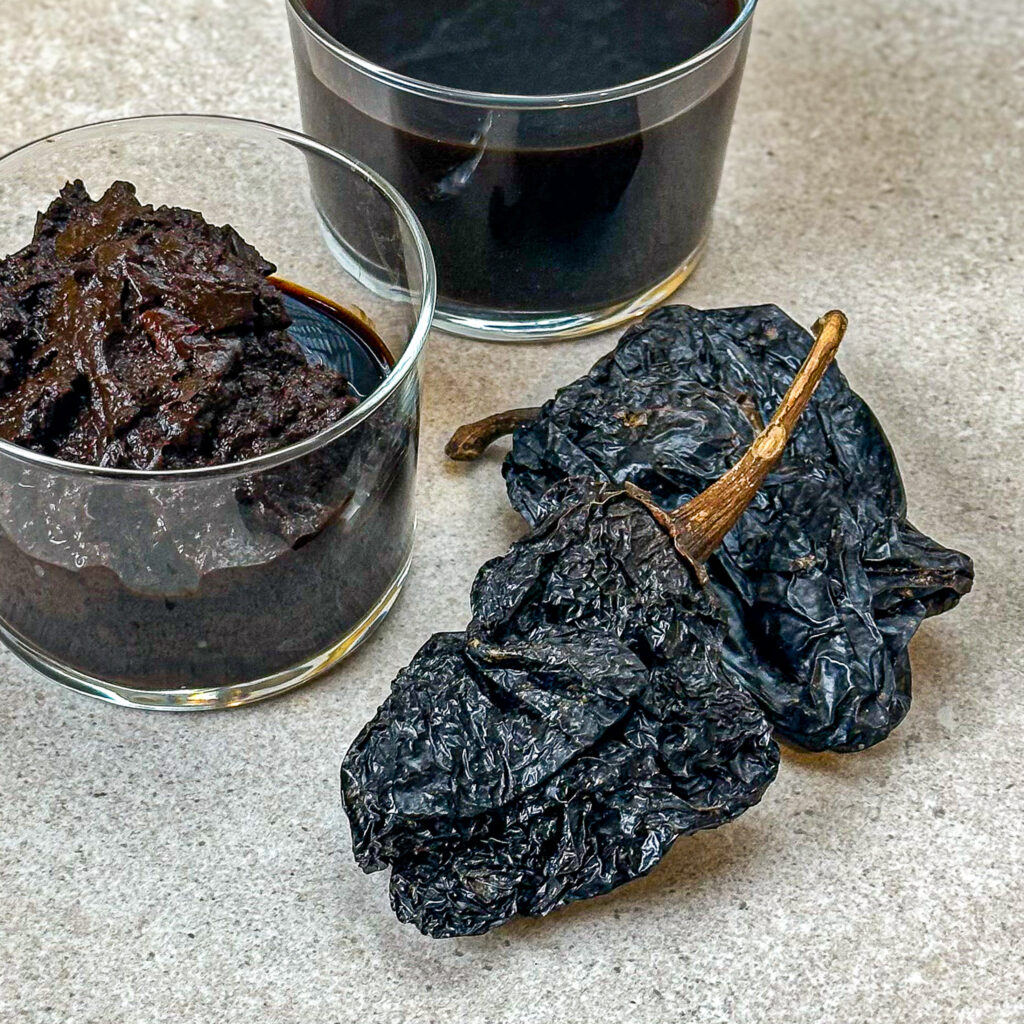
But regardless how you spell it, you will love this Tex-Mex chili, with its layer upon layer of subtle, evocative, and deeply satisfying flavors. It’s best made one or two days ahead, making it the perfect dish for a casual gathering of friends on a long, lazy, winter afternoon. Perhaps in January, with a dozen football fans (your closest friends), all glued to The Big Game, laughing, cheering, wind howling, fireplace aglow in the background.
One Last Note: I sometimes get asked this question: What’s the difference between chili and soup with the same ingredients? There are no hard and fast rules on this front, but in general Chili is thicker than Soup. After you’ve made a gorgeous chile and eaten a couple of luscious bowls over a similar number of days, you may find yourself yearning for something lighter to finish off the batch. Simply add a quality, homemade or canned vegetable broth or chicken stock to taste. And just for fun, call it Black Bean Ancho Chile Soup. Or, if you really want to blow the doors off, process a few cups of chile in a food processor, add cream to desired taste and stock to desired texture, adjust seasoning if necessary ,and title it Cream of Black Bean Ancho Chile Soup.
And definitely LAUGH and congratulate yourself on making such an interesting dish. I promise you, it will be DELICIOUS. And your friends will not forget it or you for many moons to come.
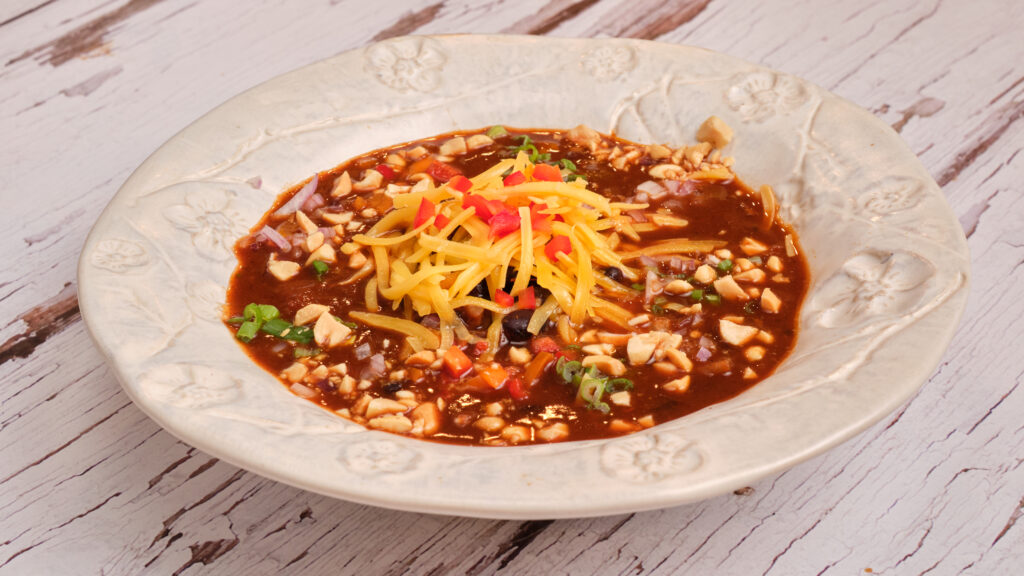
Super Bowl Sunday Black Bean Ancho Chili
This chili is a gorgeous, deep mahogany color, which sets off nicely against a white or black wide-rimmed bowl. You can add a lot of drama to the presentation by presenting a platter of colorful chopped garnishes, from which guests can choose.
The balance of flavors is perfect, with pervasive deeper flavor notes of black beans, ancho chilies, tomato, and cumin; and higher, vibrant flavor notes of cinnamon, cloves, and lime.
Finally, this chili is a meal in a bowl. At most, you might serve with a light salad (possibly containing orange or grapefruit segments) tossed with a citrus vinaigrette. Also, homemade cornbread or cornmeal muffins make a perfect accompaniment.
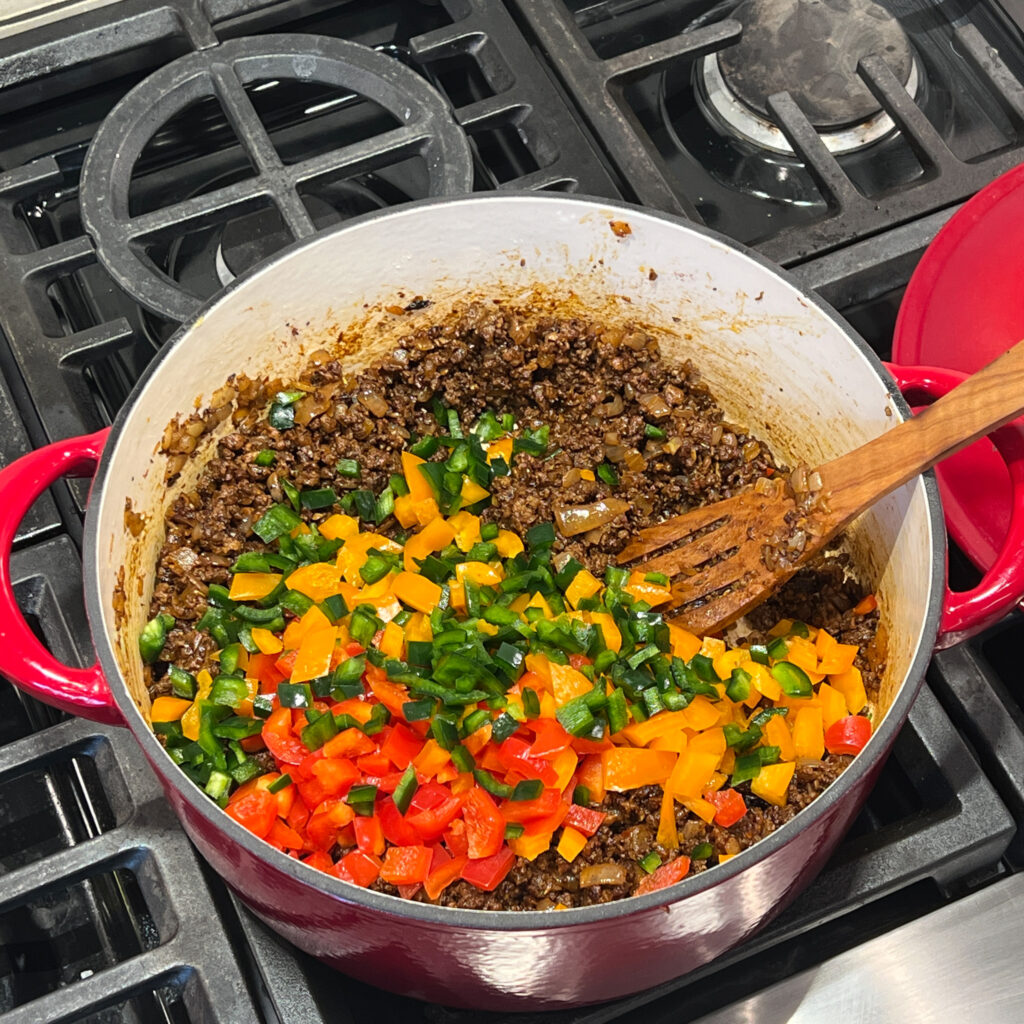
TIMING NOTE This chili benefits from a day or more of mellowing in the refrigerator, so do make it ahead if you can. In any case, you must either allow 8-12 hours to presoak the beans or use the alternate one-hour presoak method. Both methods produce good results. After presoaking the beans, allow an additional two hours to cook the beans until tender.
INGREDIENT NOTE Ancho chiles are dried poblano chiles. They are mildly piquant and almost black in color. Although I have always made this dish using ancho chiles, I could not locate them in downtown Portland this past week. Whole Foods was out of them and Safeway had no dried chiles at all. So I scored New Mexico chiles at Whole Foods and used them instead. The flavor of the finished dish was quite different from usual but excellent nonetheless. The heat level was also amplified–in a good way. The chili was not too piquant, even will a full ½ cup of New Mexico chile paste.
TECHNIQUE NOTE If you are unfamiliar with the dos and don’ts of preparing chile peppers, see this helpful picture tutorial, Preparing Dried Chile Peppers (at the bottom of the web page).
5 cups dried black beans, hydrated per instructions above (two 1-pound packages make 12 cups cooked beans) OR 6 cans (about 12 cups) black beans (removed from cans and rinsed)
4 dried ancho chiles
½ cup olive oil
3 cups minced yellow onion (one large or two medium-large onions)
two 14½-ounce cans crushed tomatoes (about 4 cups)
1½ cups diced green bell peppers
½ cup stemmed, seeded and deribbed, minced jalapeno chiles
4 cloves garlic, peeled, and minced or pressed
2 tablespoons dried cumin seed
2 tablespoons dried oregano
1½ tablespoons ancho chile powder (or sweet paprika)
½ teaspoon red pepper flakes (or more if you want a hotter brew)
½ teaspoon ground cinnamon
¼ teaspoon ground cloves
2 cups chicken stock or vegetable broth
¼ cup fresh lime juice
2 teaspoons salt (you will probably want to use more, as black beans require a lot of salt)
freshly ground black pepper
Required Garnishes
½ pound jack or cheddar cheese, grated
½ cup sour cream
1 lime, cut into 8 wedges
8 sprigs cilantro
Optional Garnishes
½ cup chopped tomato
½ cup chopped green bell pepper
½ cup chopped red, yellow, or orange bell pepper
½ cup chopped jalapeno chile pepper
½ cup chopped green onion
½ cup chopped red onion
½ cup chopped cilantro
½ cup chopped dry roasted peanuts
FOR DRY BEANS: Sort through dry beans and remove any irregular looking beans. Rinse well. Place beans in a large non-reactive (stainless steel or enamel) soup pot or stovetop casserole and add cold water to cover by 3 inches. Then, cover and let hydrate for 8-12 hours; or bring to a boil, remove from heat, cover, and let hydrate for 2 or more hours, until tender. (If beans have been have been hanging about in the back of the pantry for awhile, they’ll take much longer to hydrate.) When beans are tender, strain into a large bowl, reserving the liquid. As liquid settles, pour the lighter liquid on top into a separate container.
FOR CANNED BEANS: Remove beans from cans and rinse.
FOR ANCHO CHILES: Put dried ancho chiles in a small bowl and cover with boiling water. Let hydrate for 15 minutes, then strain water into a small saucepan and reduce to 1 cup. Reserve liquid for step 3 below. Core chiles and remove seeds. Chop finely. You’ll have 1/3 cup of intensely flavored chile paste.
- In a large soup pot or stovetop casserole, add olive oil and slowly cook onions until soft and translucent, about 15 minutes.
- To bloom spices, in a small, nonstick sauté pan, heat cumin and oregano for several minutes over medium-high heat, until fragrance is toasty but not burnt. Add paprika, red pepper flakes, cinnamon, and cloves, and then add mixture to onions. Sauté for 2 minutes.
- Add ancho chiles, 1 cup reduced chile liquid, tomatoes, green bell peppers, jalapeno chiles, and garlic to soup pot. Simmer slowly for 10-15 minutes to meld flavors.
- Add cooked black beans, 2 cups of thicker black bean liquid, and chicken stock.
- Adjust consistency of chili by adding additional cup increments of thicker black bean liquid, adding remaining thinner liquid only if necessary. For this recent batch of chili, I used a total of seven cups of liquid (counting the stock, chile soaking liquid and black bean cooking liquid).
- Add lime juice, and season to taste with additional salt and freshly ground black pepper.
- To serve, ladle 2 cups of hot chili into each heated soup bowl. Put a spoonful of sour cream on top of each serving and sprinkle with cheese. Nestle a sprig of cilantro in the sour cream. If desired, surround the chili with small bowls of each of the optional garnishes and let guests help themselves.
Serves 8.
For more great soups, bisques, and chowders, hop over to our sister blog thelunacafe.com
- Basic Little Potato & Five Onion Soup
- Cannellini Bean Soup with Italian Sausage, Fingerling Potatoes & Broccoli Raab
- Cold Green Pea Soup (Green Pea Gazpacho)
- Creamy Cauliflower Leek Soup with Curried Mustard Croutons
- Creamy Romaine Soup with Summer Herb Butter & Garlic Croutons
- Curried Pumpkin & Green Tomato Soup
- Curried Tomato & Red Lentil Soup
- Green Chile Chowder with Yellow Finn Potatoes & Italian Kale
- Heirloom Carrot Soup with Lemon Verbena, Spearmint & Garlic Gremolata
- Kamut, Kale & Cabbage Soup with Winter Pistou
- Kicky Tomato Strawberry Gazpacho
- Mexican Tortilla Soup with Frizzled Tortillas
- Really Wild Mushroom Soup: Two Fabulous Ways
- Roasted Garlic & Sunchoke Soup with Rosemary Hazelnut Pesto & Goat Cheese Crèma
- Roasted Green Chile Soup with Mexican Crema, Frizzled Tortillas & Charred Sweet Corn
- Roasted Red Bell Pepper Gazpacho
- Smoky Spanish Zarzuela with Chorizo & Emmer Farro
- Spicy, Creamy Mulligatawny Soup
- Spicy Cucumber Gazpacho
- Spicy Korean Noodle Soup (Jjambbong)
- Spicy Pork Wonton Soup
- Sweet Carrot Bisque with Umami Pesto
- Sweet Corn & Poblano Chile Chowder
- Thai Red Curry Soup
- The Perfect Vichyssoise (Cold Potato Leek Soup)
- Triple Celery Soup with Parmesan, Parsley & Garlic Croutons & Parsley Oil
- Warm Spiced Red Kuri Squash & Orange Soup with Cinnamon Harissa
Copyright 2025 Susan S. Bradley. All rights reserved.


